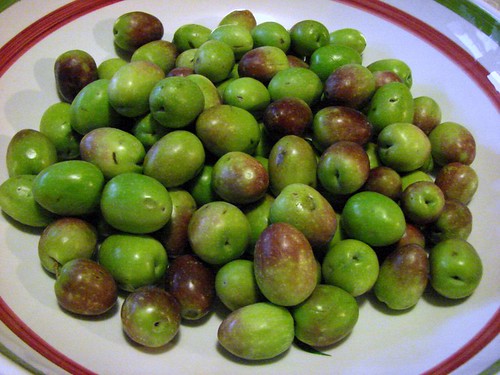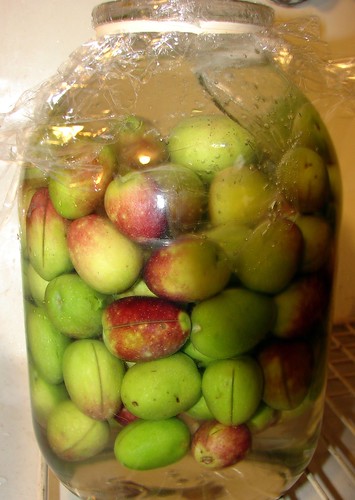 My hometown produce store has a big bin of fresh olives right now. They range from green to blushing red, and they're huge!! I've seen fresh olives in local supermarkets for years, and I've always wanted to try curing some at home. Totally impractical, of course, and one of the few things that's actually more expensive when you do it yourself - but still something that I've found intriguing. Part of the reason I never did it was because in the pre-internet days, it was pretty hard to find information about curing any kind of food, let alone olives. Nowadays, of course, getting recipes and information is as simple as typing a few keywords into Google, so I took the plunge and bought a couple pounds of fresh olives to cure.
My hometown produce store has a big bin of fresh olives right now. They range from green to blushing red, and they're huge!! I've seen fresh olives in local supermarkets for years, and I've always wanted to try curing some at home. Totally impractical, of course, and one of the few things that's actually more expensive when you do it yourself - but still something that I've found intriguing. Part of the reason I never did it was because in the pre-internet days, it was pretty hard to find information about curing any kind of food, let alone olives. Nowadays, of course, getting recipes and information is as simple as typing a few keywords into Google, so I took the plunge and bought a couple pounds of fresh olives to cure.There they are, in my big shallow pasta bowl. Big, plump and gorgeous, and anywhere from 3 to 6 weeks away from being ready to eat. I started out by dumping them all out into the pasta bowl and swishing them around to wash in cool water.
 Next, each of the olives needs to be slit, so I used a sharp paring knife to make a cut from end to end almost down to the pit. As I slit each olive, I dropped it into a 3-liter glass jar.
Next, each of the olives needs to be slit, so I used a sharp paring knife to make a cut from end to end almost down to the pit. As I slit each olive, I dropped it into a 3-liter glass jar.Then, I filled the jar with a strong plain brine at a ratio of 1 cup of kosher salt to 1 gallon of water. The olives have to stay completely submerged in order to cure properly, so I used an old trick to keep the olives submerged: I filled a plastic bag with leftover brine and topped off the olives with it before closing up the jar. The bag will keep the olives well below the surface of the brine, and putting brine instead of water in the bag guarantees that if the bag ever develops a hole, the brine for the olives won't get diluted. (You can see how this looks in the picture below - see how the olives seem to be suspended in the center of the jar? The plastic bag isn't easily visible once it's filled with brine.) I did this step in the sink, because pouring the brine into a plastic bag is kind of messy, and because I was making sure there was enough in there (completely topped off) it overflowed a little. When the jar was packed and sealed, I put it in the cool, dark kitchen closet for the curing time.
 Now comes the hard part: Waiting. Over the next three weeks, I have to visit the olives every few days and swirl the jar a little. Every week or so, the method calls for rinsing the olives and changing the brine. In about three weeks, I'm supposed to taste one of the olives to see how they're doing - if the sample is still bitter, the brine gets changed again and we sample again in a week.
Now comes the hard part: Waiting. Over the next three weeks, I have to visit the olives every few days and swirl the jar a little. Every week or so, the method calls for rinsing the olives and changing the brine. In about three weeks, I'm supposed to taste one of the olives to see how they're doing - if the sample is still bitter, the brine gets changed again and we sample again in a week.Check back with me in another week, and we'll take a peek at them.
.

Very cool! I'm looking forward to see the process and see how you enjoy them.
ReplyDeleteThis is completely new to me, and I'm keeping my fingers crossed. I have only about a 50% success rate with making sauerkraut, so the idea of keeping a jar of olives in my closet for a month and a half is kind of scary. =D
ReplyDeleteDave- you might want to check out Michael Ruhlman;s site- he just had an article on curing olives!
ReplyDeletecheezmaker
Dave - you didn't necessarily fail at making sauerkraut; that shit is just HORRID, even if you DO "succeed". Yuck.
ReplyDeleteBut olives I can dig, and am looking forward to seeing how yours turn out!! I myself am a sucker for -fresh- garlic-stuffed olives, which my ma will occasionally whip up a couple o' batches of around the holidays.
So how did these turn out?
ReplyDeleteand my powers of observation seem to be failing;
where have you seen un-cured olives in this neck of the woods?
Marc - They were...less than successful. But I'm going to try again when the olives are in the store again.
ReplyDeleteThere is a small produce store on Route 5 in Enfield, across the street from the Dunkin Donuts and Amvets, right next door to Moore Rug. When fresh olives are in season, I buy them there.
In season... The end of October? or ?
ReplyDeleteThanks!
Marc - Yeah, if I remember right, that store usually carries them for a few weeks starting in mid-October.
ReplyDeleteFood Mart and Shaw's used to sell them, too, but unfortunately both of those supermarkets have left the area.